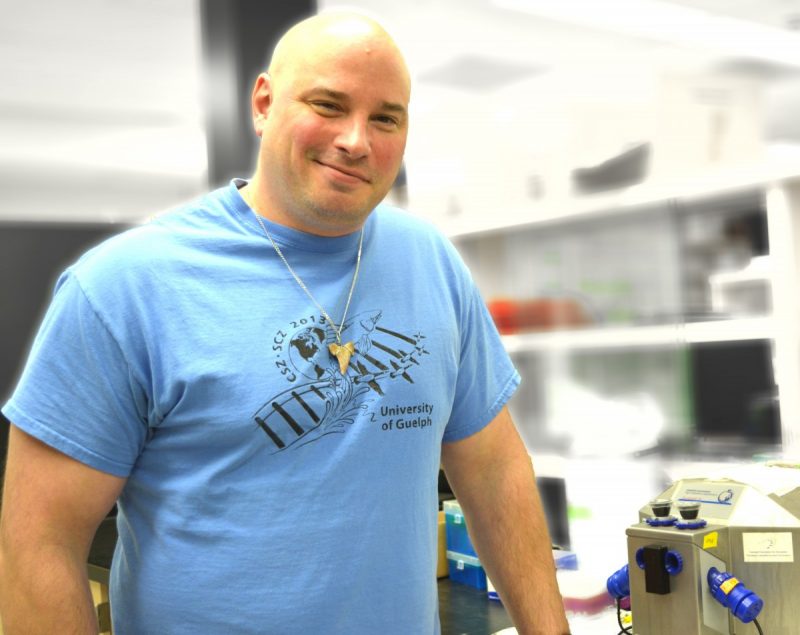
Mitochondria. Image credit: RAJ CREATIONZS/Shutterstock.
Peeling the Mitochondrial “Onion”, One layer at a time
If you receive an email from Dr. Jason Treberg, Canada Research Chair, Assistant Professor, Department of Biological Sciences, you can’t help but notice a quote from the late, great gonzo journalist Hunter S. Thompson in the signature: “Indeed, remember Dr. Frankenstein, who also reaped the fruits of his labors.” Treberg explains that “…the quote is from “Fear and Loathing in America”. [It] was a cryptic reply to [a reporter] … about his political activities. Ostensibly, your actions have consequences. Sage advice, in my opinion.”
Despite the reference to Mary Shelley’s classic tale of scientific experimentation gone horribly awry, a quick glance at Treberg’s lab in the Duff Roblin Building reveals nothing out of the ordinary. The lone occupant over this lunch hour is Masters’ student Travis Durhack, busily assessing what ‘stream-side’ physiology can be done in the field this upcoming summer.
Simply stated, Treberg, Canada Research Chair in Environmental Dynamics and Metabolism investigates how changes in the environment influence the metabolism of a given organism.
“What we want to know is: as a creature’s metabolism shifts in response to changes in the environment, what does that mean for how well it can adjust and adapt?”
Treberg continues, explaining that his lab is effectively divided into two research areas: the “fishy side” and the “furry side”. When it comes to fish, the main line of inquiry regards how environmental changes affect cellular ‘energy economy’ and function as well as potential life span. A lot of fish keep growing as they get older, unlike humans. These fish slow down, but they keep growing. Treberg wants to understand how the quality of both food and environment drive fishes’ growth, vis a vis the mitochondrial processes within fish cells. Currently, Masters’ student Lillian Wiens is studying fish heart mitochondria in order to learn more.
Mitochondria transform the energy in food into a form the cell can use. They also make things called reactive oxygen species (ROS). During times of environmental stress, ROS levels can increase dramatically. If they are overproduced, it’s damaging to the cell. Jay and his team are trying to understand where the mitochondria fit in the production of certain reactive oxygen species.

Jayson Treberg, Assistant Professor, Canada Research Chair in Environmental Dynamics and Metabolism. Photo credit: Jo Davies.
On the other side of Treberg’s lab, PhD candidate Nahid Tamanna is working on methionine restriction in rodents, which can increase their life span on par with what some consider a“gold standard” of caloric restriction. Common knowledge tells us that if we restrict calories (i.e. watch our weight), we’ll live longer. In the methionine-restricted rats, it’s been found that although they eat far more than size match controls, they don’t gain weight as expected yet live longer.
The best part of this “furry” research? If we understand the mechanisms, this should be transferrable to mitochondria for other organisms, including humans. Treberg is attempting to discover common mechanisms species mitochondria, the idea being that this will lead to a better understanding of the aging process. Dr. Daniel Munro, a recent postdoctoral fellow working with Jay, was exploring this by studying the mitochondria from exceptionally long-lived species compared to related shorter lived ones.
Research has shown that as we age, cell process starts to decline. Treberg and other biologists like him speculate that this may be due in part to declining mitochondrial function. “As long as the mitochondria are ‘happy’, they may play an important role in regulating the ROS … [but] as we age or get sick, or there’s a shift towards a dysfunctional mitochondria … they might turn against us.”
Treberg points to genetically altered strains of mice or those which have been bred to be long-lived. What exactly it is that changes their lifespan still isn’t clear. Mitochondrial ROS may or may not be involved. It’s this lack of comprehension that drives Jay and his team towards a more thorough understanding of “how normal works”, before going any further with their research.
“Every time we think we’ve got it solved, somebody comes into the lab and tries something and finds ‘oh, we didn’t account for that’. It’s really interesting science because we’re taking the standard procedures the field uses and sort of peeling layers back and seeing where ‘well, we assumed this, now it turns out that’s not a safe assumption.’ Eight years spent studying mitochondria and we’re finally where we’ve got the rat muscle figured out…I think.” Jay has some undergraduate researchers who should help evaluate that this summer.
Treberg is hopeful that once the workings of the rat muscle are understood, that knowledge can be translated to fish models, including the lake sturgeon. For reasons not yet understood, this local species of fish can live as many as one hundred fifty years.
Treberg smiles. It’s just another layer on that onion, waiting to be peeled back.
Research at the University of Manitoba is partially supported by funding from the Government of Canada Research Support Fund.






